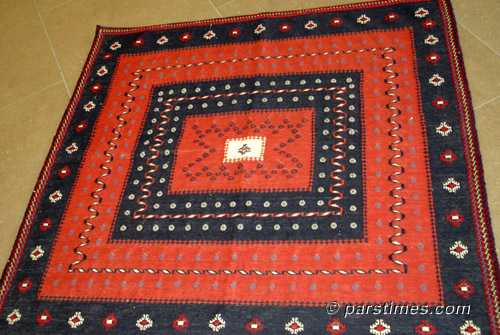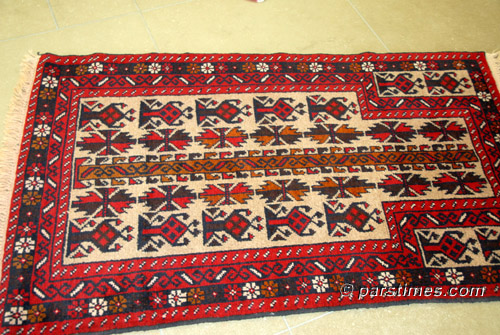
GELIM: An Embodiment of Iranian Taste and ArtBy: Sheida Nouri-Zadeh Abstract: The oldest gelim or rough hand woven floor mat in Iran belongs to the Parthian Period. Of important models one may refer to the Verni Gelim in Azarbaijan, Gelimcheh (small gelim) of Bijar and Sanandaj, Baluch gelim, Shiriki Pich which resembles carpet in shape and knots, Pelas in central regions, Masnad in Namin district of Ardabil and Ziloo around Tehran. The harmony of color and pattern is a standard to determine the value of a gelim and it wholly depends on the mentality of the weaver. Gelim is the first man-made floor mat. Archaeologists have discovered the remains of a gelim east of Anatolia island which dates back to 7,700 years ago. Of course since the raw material is vulnerable to damage, few specimens of such hand woven material have survived, but it is believed that the oldest gelim belonged to the Parthian period in Iran. Presently the majority of gelim weavers are nomadic women who are mostly settled at Dasht-e Moghan, Ahar, Arasbaran and Meshkin Shahr. Moreover all the villagers in the country and particularly peasants in East and West Azarbaijan, Bakhtaran, Kurdestan, Kerman, Kohkiluyeh- Boyerahmad provinces are engaged in that trade and villages surrounding Khoy, Boukan, Mahabad, Takab, Miandoab, Oshnavieh, Sardasht, Namein, Ardabil, Tabriz, Harsin and Firouzab are important gelim weaving centers in the country. Except floor covering, the gelim is used as a floor mat in tents and fabrication of bags, saddlebags (satchels), folding bed-clothes, horse-cloth and adornment of the walls in tents.  GELIM WEAVING EQUIPMENT Gelim weaving looms are mostly erected vertically on the ground and its warp resembles that of carpets. The warps are normally made of white cotton and the woofs are woolen and colorful. Different images with colorful woofs are used on gelims and one can often identify the locality of the gelim from the motifs and knots used on the mat. VERNI, A UNIQUE WORK OF AZARBAIJAN Verni is a carpet-like gelim with delicate and fine warp and woof which is woven without a previous sketch thanks to the creative talents of nomadic women and girls in Dasht-e Moghan, Ahar surroundings, Arasbaran and Meshkinshahr. However, the Alsoon (Shahsavan) tribes-women are exclusive producers of that gelim. Before being used in Dasht-e Moghan, Karabakh in Azerbaijan Republic was the birthplace of Verni gelim. Nowadays nomadic women and girls in Dasht-e Moghan are using red, dark blue, cream, white, light blue and a combination of pink and purple colors in the gelim. Verni weavers are employing the image of birds and animals in simple geometrical shapes imitating the earthenware patterns that were popular in prehistoric times. Gelimcheh (smaller gelim) is another product which is normally woven in Bijar and villages surrounding Sanandaj. The raw material is the same which is used in gelim. The only difference between gelim and gelimcheh is that gelimcheh is smaller in size and has diversity of colors and patterns. The gelims in the region mostly bear floral (mostly roses) and corner medallion motifs. Baluch Gelim is a stripped mat and carries darker color. Each stripe in the Baluch Gelim is a geometric form and differs with other stripes on the mat. Gelims woven in Kurdestan which employ vase and floral motifs including roses, three medallion, Vakili, tea and strawberry flowers, Mirza Ali flower and bracelet hold special status. Qashqayi gelims mostly carry bright colors found in nature, with different geometrical patterns. SHIRIKI PICH AND ITS WEAVINGShiriki Pich is another model of gelim whose name is chosen by the nomadic and village weavers. From distance it resembles a carpet and its images are produced by knots. The woof is the result of connection of all the strings on the mat in a manner that it is not visible at all like that of a carpet. The weaving of this type of gelim is difficult and time-consuming, like the weaving of a carpet. From distant past the gelim has been produced as a traditional rite for private or tribal use and is never meant for trade. The weavers of Shiriki Pitch are even more skilled than carpet weavers and its patterns and motifs are diversified and rich. The Rayeen and Afshar patterns are different in form, although the general plan is the same and the majority of patterns are used by both these tribes. The colors used in Shiriki Pitch are normally dark. Boteh Jeqeh with two flowers in the middle is a famous pattern used in the Shiriki Pich. The margin is often made of repeated geometrical forms confined in two parallel lines. This is known as circular margin. The center ground flower bears Kashmiri image. Shiriki Pitch with central medallion is rare. Other floral motifs include Khara, Gole Abbasi and Kermani. Vakili is another type of margin painted in red with parallel lines known as Abdoozi. This makes the Shiriki Pich images more bold. The Shiriki Pich loom is similar to other gelim looms and the knots are of two types. This type of gelim is popular in Kerman province and specially among the tribes, as well as part of Hormozgan province. In other regions such as Yazd a special mat known as Pelas is used which resembles the gelim. The small gelims used in Namin village in Ardabil are called Masnad and they have many fans within and outside the country. Ziloo is another division of the gelim which is apparently much coarse in texture and mostly used in summers in villages surrounding Tehran, Saveh and Kashan.  RAW MATERIAL AND DYING Gelim weavers are using silk thread, cotton thread and colorful material mostly derived from the wools shorn from their livestock. In the past they used colorful herbs such as oak bark, pomegranate, onion, hazelnut and madder roots to paint the gelim. These dyes are not as shiny as chemical paints. However, presently many regions are using chemical dyes which has lowered the quality of nomadic and village gelims. Nearly in none of the rural areas the work is divided and normally the weaver herself washes the wool, spins the thread, and does the weaving. In urban regions horizontal looms and in rural areas vertical loom is employed. The weavers are using a special instrument known as Dafleh or Dafnin in order to strengthen the fibers and the warp and woof. Besides gelim and gelimcheh some weavers employ the raw material for gelim to fabricate saddlebags, satchels, covers for cushions, laces for tents and horse-cloth. Some of these handicrafts are used in daily life and some are employed to adorn the house. STANDARDS FOR DIFFERENT GELIMSDespite diversity of size, color and patterns, the Iranian hand woven gelims employ special techniques which improve the quality of the works. These techniques are as follows: 1. The fibers in the gelim must be hundred percent wool, new and well washed or such wools be used that have been properly shorn from the skin. 2. The diameter of the fiber must be between 30 to 50 microns and the maximum fat content should not exceed 1.5 percent. 3. The gelim must be disinfected by chemical agents which kills the moth and this should be indicated on the gelim by a special sticker to inform the buyer. 4. The pile number in the single layer gelims should be 3 to 5 m. Moreover, in order to strengthen the gelim further its web should be of two layer thread. 5. The average length of fibers in the gelim must not be less than 7 cm. The pile used should contain a minimum of 20 layers in each centimeter of space. METHODS OF IDENTIFICATION OF QUALITY OF GELIM Contrary to the carpet whose identification has become a technique and ordinary people are aware of the technique, gelim connoisseurs have little background or correct standards to identify the good and bad quality of the mat. The following information can help a buyer to identify the quality of gelims: 1. Stable and durable color is an important matter in a good gelim, because a good dye helps the gelim to endure light and repeated washing. Those gelims whose raw pile have not been properly dyed and washed again easily lose their color. To see whether the dye is good or bad one can easily rub the gelim with a wet white cloth. 2. Gelims which possess more woofs are naturally superior in quality. In order to understand the density of the woofs it is enough to pull part of the gelim by two hands when you want to select it. Gelims possessing more woofs are resisting to pulling whereas gelims with fewer woofs easily disintegrate. Another point is that if no woolen thread is used in the warp, it is normally replaced by white cotton thread, and if the gelim is densely woven these strings are shown like white spots on the gelim. 3. A light gelim is another indication of superior quality. In other words the lighter the gelim the more superior its quality is because in a light gelim more delicate warp and woof is employed. 4. Contrary to the carpet in which harmony in dye, design and similarity of patterns is a value, in a gelim harmony in color and design is not considered a value because the carpet is woven by a pre-designed sketch whereas the patterns in a gelim are the inventions of the weaver's mind and each weaver leaves a different psychological impression on the mat. Thus we can see a weaver of gelim using a single pattern in different places on the gelim with different colors and different dimensions. This is a genuine characteristic and art of a special tribe and nation. It not only does not reduce the physical value of the gelim but adds to its spiritual grace as well. JAJIM, A MANIFESTATION OF NOMADIC WOMEN'S ARTJajim is popular in many villages and nomadic tribal regions. The only difference between various Jajims is their color and delicacy of thread and patterns. The most important element in a weaver of Jajim is her patience and ability. After procuring the needed thread and different dyes the Jajim is woven. The majority of Jajims are woven in an open space (such as streets or a workshops in a village). This is called the stretching of the Jajim. Special and delicate designs and patterns such as Joulma, Sirga, bricks, almond or the bezel of the ring are used in the Jajim. Since the majority of the inhabitants of Khalkhal city, Khoresh Rostam district and their surrounding villages are skilled weavers of Jajim, the Jajim woven in these regions is famous. Givi Zavieh, Nimhil, Nassaz, Barandaq, Jafarabad, Sajhrud and Chenar Liq are famous villages where Jajim is woven.
|